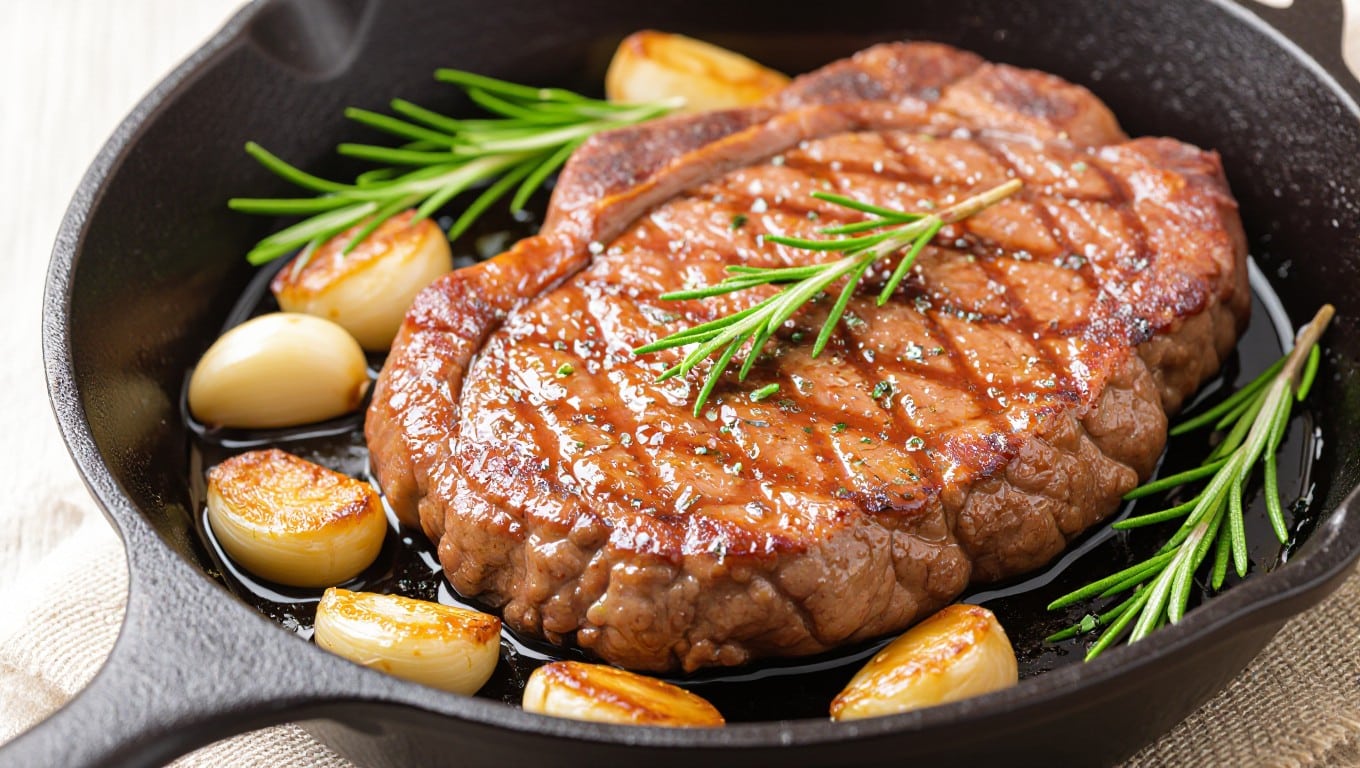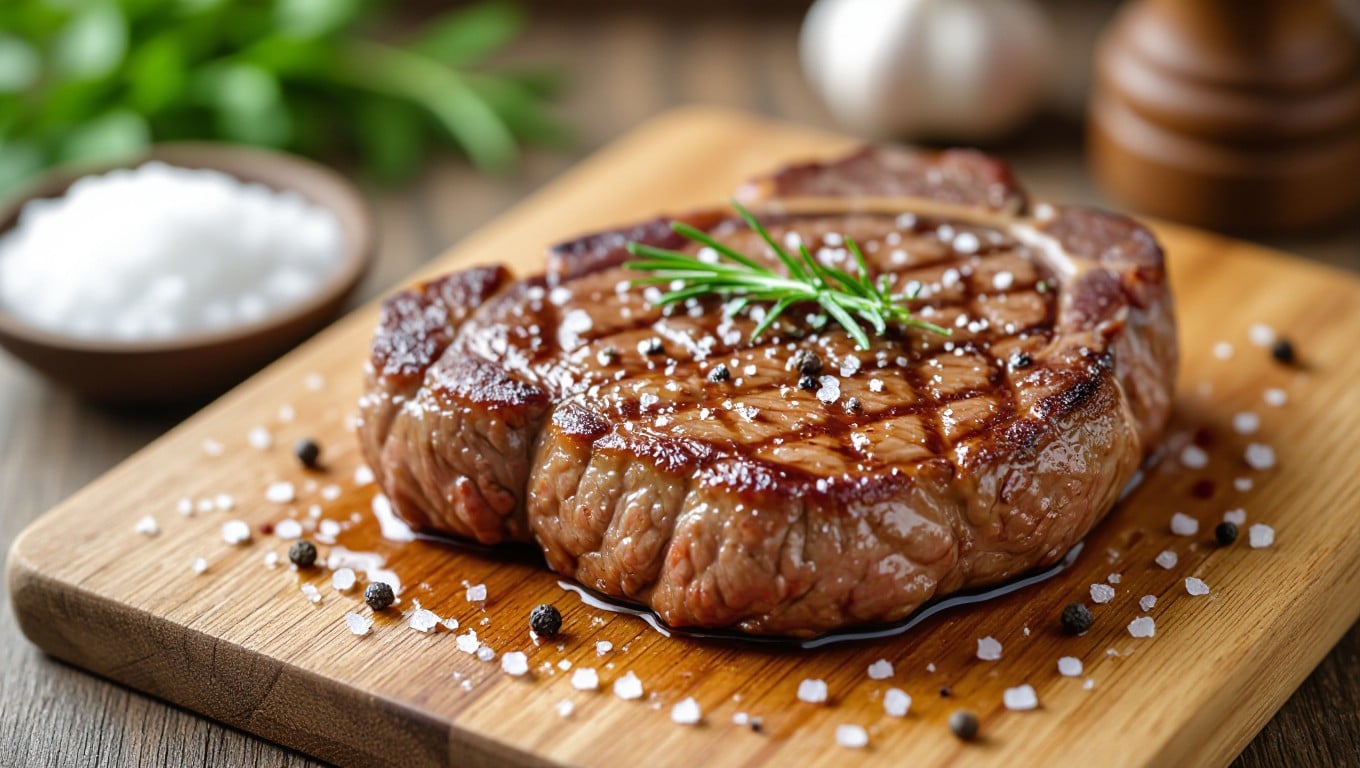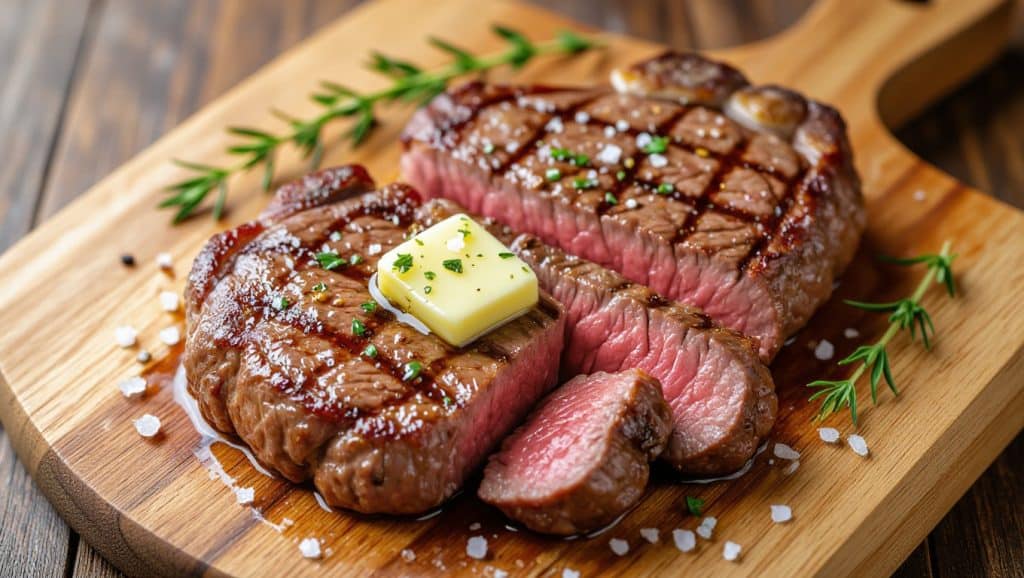Mastering the Art of Steak Selection
Learning how to cook a medium rare steak begins with selecting a good cut of steak. Look for steaks with rich marbling and bright red color, as these characteristics indicate quality and flavor. Once you have your steak, season the steak generously with salt and pepper to enhance its natural flavors.
To achieve that perfect medium-rare temperature, preheat your oven while heating a cast iron skillet or frying pan over high heat. When the skillet is hot, place the steak in the pan to sear it for 2-3 minutes on each side until a golden crust forms. Once seared, you can choose the best way to cook: either continue on the stovetop or cook steak in the oven for finishing it. If you opt for the oven, transfer the skillet directly into the oven to let it cook for an additional 5 to 10 minutes.
Use a meat thermometer to check the steak temperature; you want it to reach 130-135°F for a perfect medium rare. After removing the steak, allow it to let rest for about 5 minutes. This resting period helps redistribute the juices and ensures a juicy, flavorful steak. Finally, serve your delicious steak by slicing it against the grain and enjoy the rich taste of this perfectly cooked cut of meat.
Best Cuts for a Medium Rare Delight
Choose from these top-tier cuts that deliver exceptional results when cooked medium-rare. Ribeye offers the richest flavor, while sirloin provides excellent value. For special occasions, splurge on a tender fillet.
Premium Steak Cuts Guide
| Cut | Characteristics |
|---|---|
| Ribeye | Most flavorful, high marbling |
| Sirloin | Lean, great value |
| Fillet | Most tender, minimal fat |
The Importance of Room Temperature
Taking your steak out of the refrigerator 30-60 minutes before cooking ensures even heat distribution. Cold meat can lead to uneven cooking, with an overdone exterior and raw center.
Temperature Timeline
| Steak Thickness | Rest Time |
|---|---|
| 1 inch | 30 minutes |
| 1.5 inches | 45 minutes |
| 2 inches | 60 minutes |
Seasoning and Preparing: Setting the Stage for Flavor
Take your room-temperature steak and pat it completely dry with paper towels – moisture is the enemy of a perfect sear. A dry surface ensures that golden-brown crust you’re aiming for. Season generously with sea salt and freshly ground black pepper, pressing the seasonings into the meat to help them adhere. Let the seasoned steak rest for 10-15 minutes to allow the salt to penetrate the meat properly.
Essential Seasoning Techniques
Season your steak from a height of about 12 inches to ensure even distribution across the meat’s surface. Use 1 teaspoon of salt per pound of meat as your baseline. For extra flavor dimension, add crushed garlic cloves and fresh rosemary sprigs that you’ll use during the cooking process. Avoid using oil on the meat itself – you’ll add that to the pan later.
[VIDEO] How To Cook a Perfect Steak by Jamie Oliver
The Perfect Pan Preheat: Achieving a Smoking Hot Surface
Place your heavy-based pan (cast iron works best) over high heat for 5-7 minutes. The surface temperature should reach around 450°F (232°C) before you begin cooking. Test the heat by adding a drop of water – it should instantly dance and evaporate. Add a thin layer of high-smoke-point oil like grapeseed or vegetable oil when you’re ready to cook.

The Searing Symphony: Timing for Perfection
Mastering the perfect medium-rare steak requires precise timing and temperature control. Your pan should reach 500°F (260°C) before the steak touches the surface, creating that coveted Maillard reaction. The initial sizzle sets the stage for a beautifully caramelized crust while maintaining a juicy, pink center.
Sear Times for Steak Mastery
For a 1-inch thick steak, sear for 2-3 minutes per side on high heat. Flip only once, using tongs to protect the meat’s integrity. Your steak’s edges should develop a rich, golden-brown crust while the center remains tender. A meat thermometer should read 135°F (57°C) for perfect medium-rare results.
The Role of Aromatics: Elevating Flavor with Herbs and Garlic
During the final minute of cooking, add 2-3 sprigs of fresh rosemary, 4 crushed garlic cloves, and a knob of butter to the pan. Tilt your pan slightly, allowing the aromatic butter to pool, and baste the steak continuously with this flavorful mixture.
These aromatics create a sophisticated flavor profile that penetrates the meat’s surface. The butter browns and carries the herb essences deep into the steak’s crust, while the garlic adds subtle depth without overpowering the beef’s natural flavors. Fresh thyme or sage can substitute for rosemary, offering different but equally delicious results. Keep the garlic cloves whole and crushed rather than minced to prevent burning.
The Science of Resting: Why You Shouldn’t Rush
Resting your steak allows the muscle fibers to relax and reabsorb the juices that have been pushed to the center during cooking. A minimum resting time of 5-7 minutes ensures the internal temperature equalizes and the meat’s proteins restructure properly. During this time, your steak continues cooking slightly through residual heat, reaching the perfect medium-rare temperature of 135°F (57°C).
How Resting Enhances Juiciness
The resting period prevents the flavorful juices from spilling out when you cut into your steak. As the meat cools slightly, the proteins relax and redistribute moisture throughout the steak, resulting in a more tender and juicier eating experience. The internal temperature typically rises by 5-10 degrees during this process, completing the cooking cycle naturally.
Best Practices for Serving Your Steak
Serve your steak on a warmed plate to maintain optimal temperature. Slice against the grain at a 45-degree angle for maximum tenderness. Your perfectly rested medium-rare steak should display a warm, red center with a nicely browned crust. Finish with a sprinkle of flaky sea salt and a drizzle of the resting juices for restaurant-quality presentation.


Ingredients
Method
- Choose the right steak: Look for cuts with rich marbling and bright red color. Top picks include ribeye (rich flavor), sirloin (lean & good value), and fillet (tender)
- Bring to room temperature: Allow steak to sit out for 30–60 minutes before cooking. Thicker cuts require longer (e.g., 1 inch = 30 min; 2 inch = 60 min)
- Pat dry & season: Use paper towels to dry the steak—this ensures a great sear. Season generously with salt (roughly 1 teaspoon per pound) and pepper, pressing the seasoning in. Let it rest for another 10–15 minutes
- Preheat your pan: Use a heavy-based (ideally cast‑iron) pan. Heat it over high heat for 5–7 minutes, aiming for around 450 °F (232 °C); a drop of water should sizzle and evaporate instantly
- Add oil and sear: When the pan is hot, add a thin layer of high‑smoke‑point oil. For a 1-inch steak, sear for 2–3 minutes per side—flip only once
- Baste with aromatics (optional but recommended): In the final minute, add rosemary, garlic, and butter to the pan. Tilt the pan and continuously baste the steak with the aromatic butter mixture
- Check internal temperature: Use a meat thermometer—medium-rare target is 130–135 °F (54–57 °C). When it reaches this, remove from heat
- Rest the steak: Let it rest for about 5 minutes; this allows juices to redistribute and ensures juiciness
- Serve: Slice against the grain and enjoy.
Expert Tips for Doneness: Beyond the Thermometer
Master chefs rely on multiple methods to achieve the perfect medium-rare steak. While a meat thermometer targeting 130-135°F (54-57°C) provides accuracy, professional techniques offer more finesse. Focus on the steak’s color transformation, from raw red to the desired rosy pink center with a caramelized crust. Watch for slight shrinkage and gentle firming of the meat’s surface during cooking. Knowing these visual and physical indicators helps you develop an intuitive understanding of doneness.
- Monitor juice clarity – clear means well-done
- Watch for slight muscle fiber separation
- Look for minimal shrinkage
- Check for slight bounce-back when pressed
Touch Test Techniques for Perfect Medium Rare
The palm method remains a trusted technique among professional chefs. Make an OK sign with your thumb and index finger – the fleshy part of your palm below your thumb now matches the firmness of a medium-rare steak. Press the center of your steak gently; it should yield similarly to this palm test, offering slight resistance while maintaining springiness.
Common Mistakes to Avoid for Steak Perfection
Skipping the resting period ranks among the most frequent errors, causing precious juices to escape. Avoid repeatedly flipping or pressing the steak, which disrupts the caramelization process. Your pan must reach smoking hot temperature before the steak touches it – anything less results in gray, rubbery meat instead of that coveted crust.
Additional factors affecting your steak’s perfection include using oil with too low a smoke point, seasoning at the wrong time, or cooking straight from the refrigerator. The meat needs to reach room temperature for even cooking, while seasoning should happen right before cooking to prevent moisture loss. Choose high smoke point oils like grapeseed or avocado for better results.
Plating Like a Pro: Presentation Matters & Cook the Perfect Steak
To master the art of cooking a juicy steak, specifically how to cook a medium rare steak by Jamie Oliver, it’s essential to start with the right preparation. Begin by taking your rib-eye steak out of the fridge and allowing it to come up to room temperature for about one hour before cooking. This step is crucial as cooking a cold steak will stop the heat from penetrating properly, leaving you with a tough piece of meat.
Once your steak has reached room temperature, rub the steak with a little extra virgin olive oil and season generously with a pinch of sea salt and black pepper. This simple marinade enhances the natural flavors of the meat. Preheat a super hot pan or griddle, ensuring it’s hot enough to achieve a good color without overcooking the meat.
When you’re ready to cook, add the steak to the pan and allow it to fry for about 3–4 minutes on each side for medium-rare. Remember to turn the steak every minute to ensure even cooking and to caramelize the meat perfectly. After cooking, it’s important to stop the heat and leave it to rest on a plate for several minutes. This allows the juices to redistribute, ensuring that you are left with a tender, juicy steak.
Finally, to impress with your plating, present your rested steak at a slight angle across the plate. This not only highlights the steak’s natural beauty but also adds a restaurant-worthy touch to your meal. With Jamie Oliver’s epic rib-eye steak recipe, you can enjoy a deliciously cooked steak every time, perfect for any occasion.
Side Dishes That Complement Your Steak
Pair your medium-rare masterpiece with sides that enhance without overshadowing. Creamy mashed potatoes or triple-cooked chips provide classic comfort, while grilled asparagus or sautéed mushrooms add sophistication. For a lighter option, serve with a crisp rocket salad dressed in aged balsamic vinegar and shaved Parmesan. These accompaniments balance the rich, meaty flavors while adding color and texture to your plate.
Creative Garnishes and Sauce Suggestions
Elevate your steak with thoughtfully chosen garnishes and sauces. A pat of herb butter melting over the hot steak creates an instant sauce, while chimichurri or peppercorn sauce add bold flavors. Fresh herbs like thyme or chives provide color and aromatic finish.
The sauce selection can transform your steak experience entirely. Try Jamie’s favorite red wine reduction by deglazing the pan with a splash of good red wine and beef stock, then reducing until syrupy. For a richer option, make a quick béarnaise with fresh tarragon, or keep it simple with compound butter infused with roasted garlic and herbs. These finishing touches not only enhance presentation but add layers of complementary flavors.
From the book: 5 Ingredients Quick & Easy Food
In his book “5 Ingredients Quick & Easy Food,” Jamie Oliver provides essential tips on how to cook a medium rare steak that will help you achieve steak to perfection. He suggests starting with a high-quality cut you choose and letting it rest at room temperature about one hour before cooking. To get the steak ready, season it with salt and pepper and brush it over the steak with a bit of oil or butter. When cooking, aim to cook the steak by turning every minute on a griddle or barbecue, ensuring that the heat is penetrating to the middle without grilling it from cold, which will stop the heat from evenly cooking the meat. For perfect timing, you can expect around minutes for medium-rare doneness. Once cooked, remove to a plate and let it rest and rub with tying woody herbs like thyme to collect all the lovely juices. Finally, slice and serve for a delicious meal that is tender and bursting with flavor.
Final Words about How to Cook a Medium Rare Steak by Jamie Oliver
From above, you can see that cooking the perfect medium-rare steak Jamie Oliver-style comes down to mastering a few key elements. To make a steak, start by bringing your meat to room temperature for optimal results.
Next, season your steak with salt and pepper generously, ensuring that all sides of the steak are well-coated. Searing the steak in a hot skillet over medium-high heat is crucial; this creates that signature caramelized crust while keeping the center juicy and pink.
It’s advisable to cook a thicker steak for about 2 minutes on each side, flipping and cooking until you reach the desired temp for medium rare. To finish it in the oven, you can place the pan in the oven to ensure even cooking throughout the thickest part of the steak.
After cooking, allow the steak to rest for a few minutes; this step helps it cook evenly and enhances the flavor. Butter over the steak before serving adds richness and elevates your dish.
Your confidence in steak cooking will grow with each attempt, and soon you’ll be creating restaurant-quality results at home. Now that you have these professional insights, it’s time to fire up that pan and put your new skills to the test!
Frequently Asked Questions
How do I know when the steak is medium rare?
Use a thermometer: 130–135 °F (54–57 °C) internal temperature. Or try the touch test—slightly springy and firm—but not hard.
Why should I let the steak rest?
Resting for about 5 minutes lets the juices redistribute so the steak stays moist and tender when sliced.
Is it necessary to use butter, garlic and herbs?
They’re optional but highly recommended—basting with butter, garlic, and rosemary adds a beautiful nutty and fragrant flavor.
Can I use grill instead of a pan?
Yes—ensure the grill is extremely hot. Turn the steak every minute or so to ensure even medium rare cooking.
What steak cuts work best for medium rare?
Flat iron (feather steak), rib‑eye, sirloin and fillet all work well—cook steaks ~1¼‑1½ in (3.2–4 cm) thick for best control.

